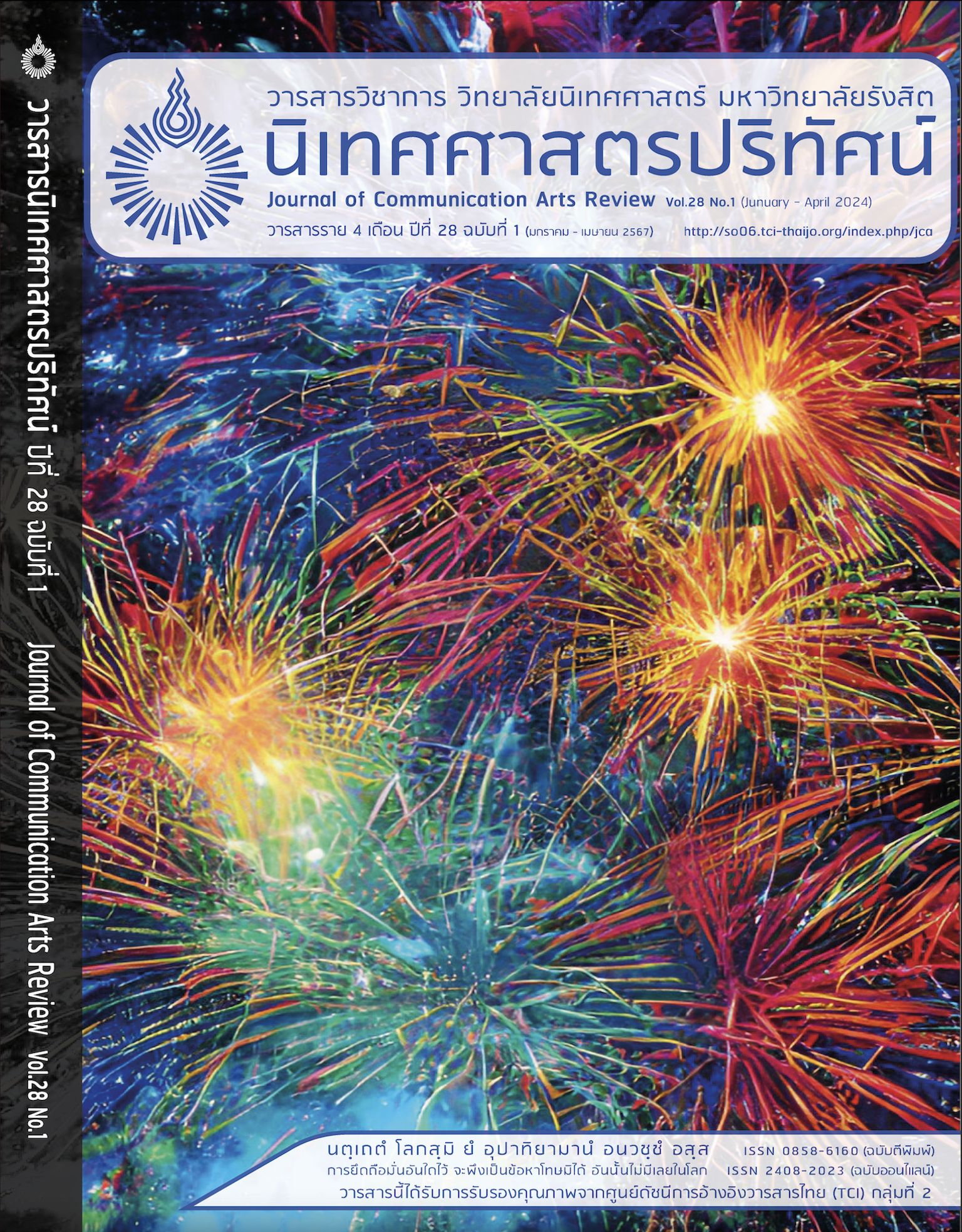การกำหนดแบรนด์สถานที่และการพัฒนาการท่องเที่ยวที่ยั่งยืนในดอยแม่สลอง: การวิเคราะห์ผู้มีส่วนได้ส่วนหลายฝ่าย
คำสำคัญ:
การสร้างแบรนด์จุดหมายปลายทาง, ทรัพยากรการท่องเที่ยว,, ผู้มีส่วนได้ส่วนเสีย, การมีส่วนร่วมของชุมชน, ดอยแม่สลองบทคัดย่อ
การศึกษานี้สำรวจมิติหลายรูปแบบของการกำหนดแบรนด์สถานที่สำหรับดอยแม่สลอง ที่เป็นสถานที่มีความเป็นที่สำคัญทางประวัติศาสตร์และทางวัฒนธรรมในประเทศไทย โดยใช้วิธีผสมผสานในการทางราชการ การวิจัยนำเสนอมุมมองของนักท่องเที่ยว มุมมองของผู้ส่งเสริมทางภาคท้องถิ่น และลักษณะเฉพาะของพื้นที่เพื่อสร้างกลยุทธ์การกำหนดแบรนด์อย่างเป็นรายละเอียด การศึกษาพบว่า จุดไปรษณีย์ในการแข่งขันของดอยแม่สลองอยู่ในความหลากหลายทางวัฒนธรรม ประวัติศาสตร์ และความงดงามของธรรมชาติ แต่ก็ระบุถึงความท้าทายเช่นผลกระทบจากการระบาดของโรคโควิด-19 และความต้องการในการจัดการอย่างมีระบบในอุตสาหกรรมบริการด้านโรงแรมและอุตสาหกรรมชาในพื้นที่ ข้อความสำคัญระบุว่า นักท่องเที่ยวรักดอยแม่สลองอย่างแท้จริงเนื่องจากสิ่งท่องเที่ยวหลากหลาย ความต้องการร่วมกันของผู้ส่งเสริมทางภาคท้องถิ่นในการเพิ่มความแข่งขันของสถานที่นี้พร้อมรักษามรดกทางวัฒนธรรมและธรรมชาติ และข้อขาดสิ่งของการจัดการในด้านการบริการที่ควรมีองค์การที่เชี่ยวชาญในอุตสาหกรรม เรื่องสรุปของการศึกษานี้มอบแนะนำกลยุทธ์สำหรับการกำหนดแบรนด์ การตำแหน่ง และการมีส่วนร่วมของผู้ส่งเสริมทางภาค เสนอแผนกาตรวจสอบสำหรับการพัฒนาการท่องเที่ยวที่ยั่งยืน
เอกสารอ้างอิง
Asker, S. A., Boronyak, L. J., Carrard, N. R., & Paddon, M. (2010). Effective community based tourism: A best practice manual.
Balakrishnan, M. S. (2009), “Strategic Branding of Destinations – A Framework” European Journal of Marketing, Vol. 43.
Balakrishnan, M. S., Nekhili, R., & Lewis, C. (2011). Destination brand components. International Journal of Culture, Tourism and Hospitality Research, 5(1), 4-25.
Buhalis, Dimitrios (2000), “Marketing the competitive destination of the future,” Tourism Management, 21 (1), 97-116.
Cadena, A. J., Pond, D., & Rattanasorn, T. (2015). Integrated livelihoods and landscape approach for smallholders in Northern Thailand. Future of Food: Journal on Food, Agriculture and Society, 2(2), 22-29.
Chaoprayoon, P., & Panyadee, C. (2014). The local economic promotion through the creative tourism travelling route: The practical application for Chiangrai province, Thailand. GSTF Journal on Business Review (GBR), 3(1).
Cui, F. (2022). KMT Troops and the Border Consolidation Process in Northern Thailand. Southeast Asian Studies, 11(2), 177-194.
Dania, M., Inpin, W., Juwitasari, R., Miyake, Y., Takeuchi, Y., & Maki, T. (2022). The Production of Safety School Space from Climate Disasters in Doi Mae Salong Forest, Upland Northern Thailand. Forest and Society, 6(2), 763-788.
Duangjai, W., Schmidt-Vogt, D., & Shrestha, R. P. (2015). Farmers’ land use decision-making in the context of changing land and conservation policies: A case study of Doi Mae Salong in Chiang Rai Province, Northern Thailand. Land Use Policy, 48, 179-189.
Eiamroengporn, R., Yordchim, S., Photchong, K., Paukinsaeng, N., Fan, L., Person, K.,& Sudmuk, C. (2023). Yunnan Chinese for Thai people of Chinese Descent on Doi Mae Salong Nok in Chiang Rai, Thailand. resmilitaris, 13(3), 71-81.
Guiry, M., & Vequist IV, D. G. (2015). South Korea’s medical tourism destination brand personality and the influence of personal values. Asia Pacific Journal of Tourism Research, 20(5), 563-584.
Hassan, Salah S (2000), “Determinants of Market competitiveness in an environmentally sustainable tourism Industry,” Journal of Travel Research, 38 (February), 239-45.
Henderson, J. C. (2007). Uniquely Singapore? A case study in destination branding. Journal of vacation marketing, 13(3), 261-274.
Hjalager, A. M. (2011). The invention of a Danish Well-being Tourism Region: Strategy, substance, structure, and symbolic action. Tourism Planning & Development, 8(1), 51-67.
Medaric, Z., Sulyok, J., Kardos, S., & Gabruc, J. (2021). Lake Balaton as an accessible tourism destination–the stakeholders’ perspectives. Hungarian Geographical Bulletin, 70(3), 233-247.
Mousavi, S. S., Doratli, N., Mousavi, S. N., & Moradiahari, F. (2016). Defining cultural tourism. In International Conference on Civil, Architecture and Sustainable Development (Vol. 1, No. 2, pp. 70-75).
Nare, A. T., Musikavanhu, G. M., & Chiutsi, S. (2017). Tourism diversification in Botswana-a stakeholder perspective. African Journal of Hospitality, Tourism and Leisure, 6(3), 1-14.
Stephens Balakrishnan, M. (2008). Dubai–a star in the east: A case study in strategic destination branding. Journal of Place management and Development, 1(1), 62-91.
Suprakarn, A. (2013). AN INTERPRETATION PLAN FOR HERITAGE TOURISM PROMOTION IN CHIANG SAEN DISTRICT, CHIANG RAI (Doctoral dissertation, Chulalongkorn University).
Trupp, A. (2014). Ethnic tourism in Northern Thailand: Viewpoints of the Akha and the Karen. Department of Geography and Regional Research, University of Vienna.
Uroševic, N. (2012). Cultural identity and cultural tourism: Between the local and the global (a case study of Pula, Croatia). Singidunum journal of applied sciences, 9(1), 67-76.
Vengesayi, S. (2003). A conceptual model of tourism destination competitiveness and attractiveness. In Australian and New Zealand Marketing Academy Conference 2003 (pp. 637-647). Australia & New Zealand Marketing Academy (ANZMAC).
Wang, Y., & Fesenmaier, D. R. (2007). Collaborative destination marketing: A case study of Elkhart county, Indiana. Tourism management, 28(3), 863-875.
Wheeler, F., Frost, W., & Weiler, B. (2011). Destination brand identity, values, and community: A case study from rural Victoria, Australia. Journal of Travel & Tourism Marketing, 28(1), 13-26.
Zhang, J. J. (2010). Brand (ing) Kinmen: a tourism perspective. International journal of entrepreneurship and small business, 9(4), 407-433.


